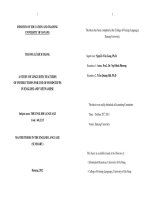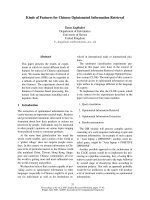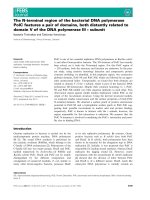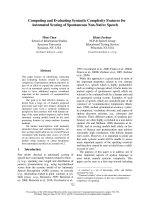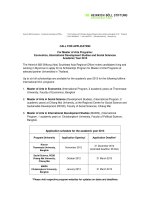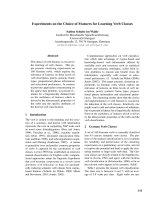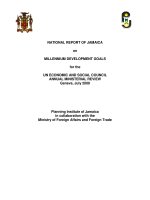CNN-based features for filtering of crisis related social media messages
Bạn đang xem bản rút gọn của tài liệu. Xem và tải ngay bản đầy đủ của tài liệu tại đây (921.35 KB, 11 trang )
TNU Journal of Science and Technology
227(14): 03 - 13
CNN-BASED FEATURES FOR FILTERING
OF CRISIS RELATED SOCIAL MEDIA MESSAGES
*
Dao Nam Anh, Nguyen Quynh Anh , Le Manh Hung
Electric Power University
ARTICLE INFO
Received:
07/6/2022
Revised:
03/8/2022
Published:
04/8/2022
KEYWORDS
Image Patten
Filter
NLP
CNN
Social media message
ABSTRACT
Analysis of the likelihood of attributes like real or false awareness,
given a series of message from social media, is a common problem in
natural language processing (NLP). This paper presents a reliable
method for categorizing emergency of messages in Tweeter. We rely
on representation of text features by image patterns instead of using
original features extracted from text message. The initial text features
were extracted with morphological segmentation and statistical analysis
of appearance of keywords in messages by NLP techniques. In order to
increase the classification accuracy image patterns-based approach was
implemented. The transformation of text features into image allows
applying convolution operations for patterns detection. This opens the
way to combinations of NLP and image analysis where the powers of
both are preserved. Convolutional neural networks were performed
with image patterns for the final social media sentence classification.
Pros and cons of the method were discussed along with comprehensive
report of performance.
SỬ DỤNG MẠNG CNN TRÍCH RÚT ĐẶC TRƯNG
LIÊN QUAN ĐẾN CÁC TIN NHẮN KHẨN CẤP TRÊN MẠNG XÃ HỘI
Đào Nam Anh, Nguyễn Quỳnh Anh*, Lê Mạnh Hùng
Trường Đại học Điện lực
THÔNG TIN BÀI BÁO
Ngày nhận bài:
07/6/2022
Ngày hồn thiện:
03/8/2022
Ngày đăng:
04/8/2022
TỪ KHĨA
Đặc trưng ảnh
Trích rút đặc trưng
Xử lý ngơn ngữ
Mạng CNN
Mạng xã hội
TĨM TẮT
Từ các thông tin trên các trang mạng xã hội, bài tốn phân tích xác định
nội dung là thật hay giả là một vấn đề cần nghiên cứu trong xử lý ngơn
ngữ tự nhiên (NLP). Bài báo trình bày một phương pháp để phân loại
trường hợp cấp thiết trong các tin nhắn trên Tweeter. Nhóm nghiên cứu
dựa vào biểu diễn các đặc trưng văn bản bằng các mẫu hình ảnh thay vì
sử dụng các đặc trưng text được trích xuất trực tiếp từ tin nhắn văn bản.
Trong các kỹ thuật xử lý ngôn ngữ tự nhiên, các đặc trưng text thường
trích chọn dựa trên việc phân đoạn hoặc phân tích thống kê tần suất xuất
hiện của các từ khóa trong các tin nhắn văn bản. Để làm tăng độ chính
xác của việc phân lớp nhóm nghiên cứu đã cài đặt một phương pháp dựa
trên nhận dạng các mẫu ảnh. Việc chuyển từ đặc trưng text thành ảnh cho
phép áp dụng các phép tốn tích chập để nhận dạng các mẫu. Điều này
mở ra một sự kết hợp giữa NLP và phân tích hình ảnh. Bài báo sử dụng
mạng nơ ron tích chập (CNN) thực hiện với các mẫu ảnh để phân lớp các
câu. Nghiên cứu cũng được so sánh với các phương pháp khác để đánh
giá trong phần mô phỏng so sánh của nghiên cứu đề xuất.
DOI: />*
Corresponding author. Email:
3
Email:
TNU Journal of Science and Technology
227(14): 03 - 13
1. Introduction
There is nowadays a robust demand for automated argument mining systems which can infer
or understand more complex argumentative structures. In particular enabling extraction of
domain specific information for disaster monitoring and risk management is an essential problem
in natural language processing. Its horizon of applications includes but not limited to information
retrieval [1], outbreak detection [2], hazard estimation [3], and damage assessment [4],
evacuation behavior study [5] health and disease analysis and propagation detection [6],
quantifying controversial information [7], and sentiment analysis [8], [9]. The latter puts forward
the significant motivation for this work, which is related to monitoring emergency situations in
social media by learning patterns of natural language messages in order to identify real disaster
events. These events are of substantial interest in monitoring intention and ignoring false
disturbances in social media.
For instance, some natural disaster like earthquake taking place, communication among
people in social media could give valuable information for evacuation, rescue, and donation.
However, while the use of social network seems appealing, the rise of the likelihood of improper
or incomplete information sharing is remarkably observed.
It is just a strong demand of natural language processing used to improve the classification of
information. This makes the assessment of discussion on social media available for monitoring
disaster, in such a way that inappropriate awareness can be detected and reliability of message
processing can be enhanced.
In this work we focus especially on sentiment analysis in social media sentences by learning
patterns of texts and implementing CNN over image patterns that represent the features of the
texts. The objective is to qualify awareness of disasters noticed in social messages. To the best of
our knowledge this work is one of the first attempts to interpret social messages patterns by
composing images from extracted features allowing implementation of CNN for image patterns.
The results with a disasterrelated Tweeter message benchmark database show the effectiveness of
the proposed method.
A number of researchers have attempted to deal with sentiment analysis and the classification
of social messages by searching methods for enhancing reliability of text reprocessing and
classification in the presence of various grammatical nuances, cultural variations, slang and
misspellings. Aiming to review related work we look into two groups of interest: (I) the works
focused on major linguistical analysis and (II) application of learning techniques for the field of
advantage of the sentiment analysis.
(I) To facilitate analysis of text corpora that describe long-term recovery, Lin et al. [10]
employed a statistical syntax-based semantic matching model for a standard, publicly available
training dataset. The method can be useful for an appropriate news article corpus and, potentially,
large corpora in general. A disaster-related news corpus was a successful stud case in the scope
of the paper. Verma et al. [11] showed that a classifier based on low-level linguistic features
performs well at identifying tweets that related to situational awareness. Then, linguistically
motivated features including subjectivity, personal versus impersonal style, and register are
proved to substantially improve system performance. Selecting key features of user behavior can
aid in predicting whether an individual tweet will contain tactical information.
Compared to these in the literature, their focus on linguistical features is always significantly
dominant for the natural language processing (NLP) problem. We do not focus on the term in the
work. However, the linguistical methods proved to be robust under a considerable amount of
noise for getting linguistical features applied in our text preparation task. Then, the features are
processed further by deep learning.
(II) Li et al. [12] proposed to apply a domain adaptation approach, which learns classifiers
from unlabeled target data, in addition to source labeled data. Naive Bayes classifier, together
4
Email:
227(14): 03 - 13
TNU Journal of Science and Technology
with an iterative self-training strategy were implemented in their experiments which used a selftraining iterative strategy to incorporate labeled data from a source disaster and unlabeled data
from an emerging target disaster into a classifier for the target disaster. Stowe et al. [13]
addressed classifying disaster-related tweets with Twitter data generated before, during, and after
Hurricane Sandy in the fall of 2012. Here, baseline features are the counts of uni-grams in tweets,
after pre-processing to remove capitalization, punctuation and stop words. Different classification
models including parameter optimization like SVM regularization and feature selection methods
were experimented using uni-grams for relevance classification. Then the best-performing
approach was selected.
A rich set of features that include Bag-of-Words, text-based, and user-based features for
traditional models were used in BERT-based models for the informative tweet classification
problem by Joao [14]. Machine learning methods for automatically identifying informative
tweets among those that are relevant to a target event were studied to propose a hybrid model that
leverages both the handcrafted features and the automatically learned ones.
Long Short-Term Memory (LSTM) was proposed by Hochreiter et al. [15] to deal with the
vanishing gradient problem. The initial version of the LSTM block included cells, input and
output gates. A deep learning model combining attention based Bi-directional Long Short-Term
Memory (BLSTM) and Convolutional Neural Network (CNN) was used by Kabir et al. [16] to
classify the tweets under different categories. Pre-trained crisis word vectors and global vectors
for word representation were implemented for capturing semantic meaning from tweets. Feature
engineering then is used to create an auxiliary feature map.
In this work, we focus especially on a novel variational approach that integrates several of the
above-mentioned concepts including preprocessing to remove capitalization, punctuation and
stop words, linguistical feature engineering with BERT-based models. It is further shown that
presentation of text features by image allows implementing different CNN models. This has two
major effects: Firstly, it becomes feasible to unite the CNN technique, which was image
originally motivated, into an NLP domain. Secondly, it shows a theoretically sound way of how a
particular tweet messages classification problem can be solved with an effective pattern
recognition technique.
2. The proposed method
The following summarizes the method for classifying social media messages. Given a
message s, a class c can be associated with the message. To describe the learning process in our
method, we use Bayes’ Rule [17] that expresses conditional probability for message sample s and
class c.
p(c|s) = p(s|c)p(c)/p(s)
(1)
From any query message sample s, the maximum a posteriori (MAP) most likely class c,
appropriate for s, can be determined by a Bayesian decision where C is the set of classes.
cMAP = argmaxc∈C p(c|s)
(2)
Here, Bayes’ Rule (1) enables to show the most likely class c
∈
( | ) ( )
( )
(3)
Then, the denominator p(s) can be dropped
cMAP = argmaxc∈C p(s|c)p(c)
(4)
The arrow in Figure 1a clearly shows that at the classification for message s is based on direct
relationship between message s and class c, i.e. most judgments are based on text-form of the
original message. However, this was not always observed.
5
Email:
227(14): 03 - 13
TNU Journal of Science and Technology
Figure 1. a. Relation between sample s and class c; b. Image f is determined by s,
and then convolution operation on f allows having g.
The fact that representation of encoded text message by 2D image allows us implementing
convolutional techniques and extracting CNN based features. In our model, words can be split
from any message sample, and then encoded by tokenization, which refers to lexical analysis [18]
for converting a sequence of characters into a sequence of tokens. In addition, tokens are strings
with an assigned and thus associated meaning. Thus, a text message sample s can be encoded into
a vector of real numbers. Note that the vector can be normalized so that values of each vector
member belong to interval [0, 1]. Using five integers in interval [0, 255] a real value in the
interval [0, 1] is represented now by one of 256 ∗ 5 = 1280 integers. The vector is then reshaped
into 2D array. As a gray image is a 2D matrix of pixels which have discrete values in the interval
[0, 255] the input message is converted to a gray image. We mark tran function for the task of
transforming a text message s to an image f:
f = tran(s), f ∈ R2
(5)
Given that the gray image f contains encoded features of the original message and a kernel h, a
convolution operation can be performed to get presentation g for s:
(
)
) ∑
∑
(
) (
∗ (
)
(6)
where x, y are location of a pixel in the image, while (2a+ 1)∗(2a+ 1) is the size of the
convolution kernel. At this point, convolution is an important application of integration. We
implemented CNN for processing images derived from text messages. It is important to
emphasize in our case study for analysis of the social message with assistance of VGG16,
GoogleLeNet, Inception V3 and ResNet101.
VGG16 [19] is CNN designed for images of fixed size of 224*224 and outputs a vector of
1000 values. GoogleLeNet (or Inception V1) [20] was proposed by research at Google with the
architectural decisions that is based on the Hebbian principle and the intuition of multi-scale
processing. Inception V3 [21] is a convolutional neural network for assisting in image analysis
and object detection, and got its start as a module for GoogleLeNet. Input image has a size of
299*299. ResNet101 [22] is Residual CNNs for image classification tasks with constructed 101
layers for input image of a size of 224*224. All above CNN networks output a vector of 1000
real values, which are formally denoted by mentioned symbol g. Figure 1b illustrates the
introduction of the image-based representation by f and the output of CNN by g for the original
relation between the text message s and the class c. When a message g needs classification, using
(3-6) a most likely class c can be estimated:
( ̂| ) ( )
(7)
∈
̂)
(
By dropping p( ̂) from (7) classification for test message gˆ is derived as follows:
cMAP = argmaxc∈C p( ̂|c)p(c)
(8)
It’s clear that p(c) from (8) can be estimated by training data with appearance of pairs of
messages and assigned class:
( ) ∑ ( | ) ( )
(9)
Since a number of messages g is available for learning, the similarity of the test message ̂
with the training message can be measured. If modeled as a Gaussian function, we can express
mathematically the similarity by a likelihood function.
6
Email:
227(14): 03 - 13
TNU Journal of Science and Technology
( ̂| )
√
| |
(
(̂
)
)
(10)
The function involves correlation using a multivariate Gaussian, where σ is the covariance.
So, the availability of measure (10) allow us to have formula (11):
( ̂| ) ∑ ( ̂ | ) ( | )
(11)
When data training has been trained, class estimation for c by (8) is fulfilled with assistance of
(9-11). In addition, accuracy is the performance metric for our case study. Its definition is based
on true positive (TP), true negative (TN), false negative (FN), and false positive (FP)
Acc = (TP + TN)/(TP + TN + FP + FN)
(12)
To demonstrate that the combination of the linguistical features extraction with the CNN is
needed to be performed in training stage in Figure 2, two essential tasks were included. In the
first, the ImageTransform(s), that creates an image from a message’s text features. In the second,
a CNN model is built by CNN (f). These tasks are seen in the test stage where test data is the
object to apply.
Figure 2. Primary path of CNN based method
3. Experimental results
To evaluate the performance of the method, a set of social media messages from Kaggle [24]
was used. In this database 10,000 tweets were hand classified. As for the message classification,
the data analysis and image analysis by CNN were taken into consideration in our experiment. So
far, the experiments perform classification of tweet messages into real disaster and not disaster
message following described method in section 3. It runs into two main stages: (I) Data Analysis
covering mainly linguistic operations; (II) Image Pattern Analysis by providing CNN.
(I) Data Analysis
The Bayesian approach [18] from section 3 has set-up around the use of the data to search
relation of text messages with classes. A message shown on a tweeter application, based on
measured color coordinates, is checked initially by data cleaning process, where symbols and
numbers are removed. By collecting and analyzing the length of messages for two classes
including Not Disaster and Real Disaster, Figure 3 shows that the number of texts having length
under 120 for real disaster appeared lower for the other class. The contradiction is not shown for
text with longer length.
7
Email:
TNU Journal of Science and Technology
227(14): 03 - 13
This is due the fact that people who are being in real case of disaster have not much time for
writing or sharing information. The most intention at that moment is given for tasks to deal with
actual dangerous situation. This enables us to determine the feature of message length with high
interest in learning. As such, a study on distribution of number of words appeared in a message can
show undoubtable distinction for the class of real disaster. Figure 4 displays the distribution of
number of words for both classes, showing low level for the class of real disaster for text having 10
to 22 words. This notation yields principled features based on the number of words in a tweet.
Figure 3. Length of tweets vs. number of tweets
Figure 4. Kernel distribution of number of words
In terms of the length of words, the curve of distribution for real disaster is allocated in the left
to tell that messages of real disaster are usually shorter than other class. Figure 5 also draws red
curve for fake disaster higher than real cases. Likewise, we addressed to the kernel distribution by
creating features based on the length of words for each tweet data sample. By using statistics for
words from the Tweeter database, frequency of each word can be estimated. If a font size is set to
be proportional with the frequency, then a picture can be shown by Figure 6. The most frequently
used words are via, new, people, storm, don’t, day, weapon and go. Using the analysis of statistics
for words as a basis, specific features were created for our text samples. To analyze the similarity of
words we use additional data set of Google News by BERT-based models. What is interesting is the
database allows us to find similar words for a given word, and the distinction between words is also
estimated. Figure 7 demonstrates a map where distance show level of distinction of words. Given a
set of words showed in the right column of the Figure 7, the words and their similar are located in
the map with colors. Therefore, the similarity of words in message with other words can be
evaluated and this supported to create corresponding features for tweet messages.
Applying data analysis for the text messages, we discovered different distributions between
two classes and a set of features were created for original text database. However, the distinction
is not clear enough for classifying the tweeter messages, and we continue the study in the next
session with assistance of image patterns.
(II) Image Pattern Analysis
Many NLP systems use tokens to represent text message by array of numbers. We
transformed each tweet message to a vector using a tokenization centric approach, which is based
8
Email:
TNU Journal of Science and Technology
227(14): 03 - 13
on number of occurrences for each word in the whole data set. Thus, the more a word turns out in
the database, the less it has bias as a feature.
Figure 5. Kernel distribution of average words length
Figure 6. WordCloud of train tweets
Figure 7. Visualizing similar words from Google news
Figure 8. Image patterns examples
Array of real value attained by the tokenization then enriched by features mentioned above.
Once the numerical feature array has been identified, its members can be normalized to real
values in the interval [0,1] for converting to image later. Note that, normalization for features is
conducted for training data and test features separately. As value interval of the two set of
features are different, we transform training features to interval of [ϵ : 1-ϵ], ϵ = .05 but not to [0:1]
in order to reserve space for values of test features which are out of value domain of the training
data. The final feature result is used for creating image f mentioned in formula (5).
9
Email:
227(14): 03 - 13
TNU Journal of Science and Technology
Figure 8 shows images which are results of transformation from feature arrays of tweets.
Actually, these images are darker. However, we make the images lighter for better printing. Notice
that the patterns of images are totally different each other and it is easy to recognize this under
normal lighting condition. The transformation gives us 10,000 images of size 224*224 and other
10,000 images of size 299*299. The size of 224*224 is used for VGG16 [19], ResNet101 [23], and
GoogleLeNet [20]. The Inception V3 [21] uses image of size of 299*299 for its input [22].
Here are examples of conversion of a text message to an image.
A further implementation of CNN for the database of images allows us to get final feature for
each image. This is a vector of 1,000 real values, which are used for classification. The feature
was named as g in previous section and the learning process was explained by formulas (7-11).
Our experiments applied cross validation with five splits, each split has 70% number of messages
for training and 30% for testing. Evaluating each split by accuracy metric described by formula
(12) gives us possibility to get averaged accuracy from the cross validation.
(III) Performance Evaluation.
The classification for the tweeter messages database with support of image patterns and CNN
VGG16 [19] provided accuracy of 73.70%. Learning by GoogleLeNet [20] offered 75.71% of
accuracy, with 2% higher than VGG16. By applying ResNet101 [23] for the image database, one
gains accuracy of 77.65%, again having 2% higher the GoogleLeNet. By using input image of
fixed size of 299*299 and specific CNN conFigureuration of Inception V3 [21], 82.42 is the best
accuracy rate that we have achieved from the experiments. Table 1 shows the accuracy results by
test splits and the averaged scores.
In particular, NLP analysis including the tokenization techniques, kernel distributions analysis
and image patterns with CNN are joined in solving the tweet disaster classification problem.
Based on a range of experimental CNNs, the Inception V3 have shown that this is the most
suitable solution for the tweet message database.
Table 1. Accuracy results by testing in 5 splits
Method/split
VGG16 [19]
GoogleLeNet [20]
Inception V3 [21]
ResNet101 [23]
1
62.30%
81.45%
86.25%
76.67%
2
76.67%
81.45%
76.67%
81.45%
3
76.47%
76.67%
81.45%
67.08%
4
71.61%
71.88%
86.25%
89.13%
5
81.45%
67.08%
81.45%
73.90%
Average
73.70%
75.71%
82.42%
77.65%
In related works other methods were implemented for the same NLP domain. Table 2 lists
results by accuracy for reference. To address tweets classification problem in disaster
management field, Ma G. [25] applied BERT architecture for transfer learning. The standard
BERT and other customized BERT architectures were trained to compare with the baseline
bidirectional LSTM with pretrained Glove Twitter embeddings. The BERT and BERT-based
LSTM were reported with outperforming the baseline model in the experiment. Muhammed et al.
[26] have employed LSTM networks for the classification considering the whole text structure
using long-term semantic word and feature dependencies.
Bernhard et al. [27] addressed social media feeds to detect emergencies and extract significant
information to support rescue operations. The proposed stream filter consists of posts analysis,
facts extraction through natural language processing. The stream filter and event clustering
allowed extracting event information from post texts. It is interesting to analyze and exercise text
mining on twitter messages dividing tweets into 2 categories covering disaster related and not
disaster related. Goswami et al. [28] used Decision Tree CART algorithm for the classification
task. The degree of accuracy can depend on many factors. The data clearance and initial statistics
analysis for text messages are the first remarkable tasks for removing noise and selecting suitable
method. Each text database has its characters and appropriate method need to be explored.
10
Email:
TNU Journal of Science and Technology
227(14): 03 - 13
We have reported experiments for tweet disaster message classification. The study case shown
that, after tokenization stage and feature extraction from kernel distributions, the feature array of
a text message was processed to be transferred to images to apply CCN methods designed for
images. The approach could be failed if the vectorized text data appeared short vectors, which
provide insufficient number of features for CNN works. Thus, the combination of NLP method
and image pattern CNN needs strong linguistic analysis and kernel distribution extraction in the
initial stage of learning.
Table 2. Results for reference
Method
BERT [25]
LSTM CNN [26]
NLP [27]
Decision Tree CART [28]
VGG16 [19] (our)
ResNet101 [23] (our)
GoogleLeNet [20] (our)
Inception V3 [21] (our)
Database
CrisisLexT26
Hurricane Irma
Hurricane Irma
Hurricane Irma
Kaggle Tweeter
Kaggle Tweeter
Kaggle Tweeter
Kaggle Tweeter
Accuracy (%)
67.00
74.78
81.89
71.50
73.70
75.71
77.65
82.42
4. Conclusion
The article presented an image pattern-based method for an NLP problem. The CNN method
groups image patterns together with NLP tokenization and feature engineering to perform
classification for tweet disaster messages. The resulting class represent true or fake news that
need to be detected. Consequently, this method is potentially very valuable for text message
classification with assistance of image patterns. Within the early stage, a range of text leaning
and text analysis is essential to remove noise and to create new features based on kernel
distribution. The transformation of the feature set to image allows selecting suitable learning
method for implementation.
The variety of the CNN methods grants a set of solutions to select one. To facilitate
differentiation between methods, text data is processed by the same preparation to get
representation by images. It can be seen from experimental results that image patterns of the text
database were classified the best by Inception V3. This is caused by the suitability of the CNN
method with the database. Results from experiments have so far have given confidence, setting
an opening base for carrying out further study into implementation of various image patterns
techniques for text classification. Future research will cover categorizing tweet messages by
searching other CNN methods for performance improvement.
REFERENCES
[1] J. R. Finkel, T. Grenager, and C. Manning, “Incorporating non-local information into information
extraction systems by Gibbs sampling,” Proceedings of the 43rd Annual Meeting of the Association for
Computational Linguistics (ACL’05), 2005, pp. 363–370.
[2] Y. Kryvasheyeu, H. Chen, E. Moro, P. V. Hentenryck, and M. Cebrian, “Performance of social
network sensors during Hurricane Sandy,” PloS ONE, vol. 10, no. 2, 2015, Art. no. e0117288, doi:
10.1371/journal.pone.0117288.
[3] B. Herfort, J. P. Albuquerque, S. J. Schelhorn, and A. Zipf, “Does the spatiotemporal distribution of
tweets match the spatiotemporal distribution of flood phenomena? A study about the River Elbe Flood
in June 2013, Twitter Analysis of River Elbe Flood,” Proceedings of the 11th International ISCRAM
Conference, May 2014, pp. 1-6.
[4] B. Resch, F. Uslander, and C. Havas. “Combining machine-learning topic models and spatiotemporal
analysis of social media data for disaster footprint and damage assessment,” Proceeding of the
Cartography and Geographic Information Science 45.4, 2018, pp. 362-376.
11
Email:
TNU Journal of Science and Technology
227(14): 03 - 13
[5] K. Stowe, J. Anderson, M. Palmer, L. Palen, and K. Anderson, “Improving Classification of Twitter
Behavior During Hurricane Events,” Workshop on Natural Language Processing for Social Media,
2018, pp. 67-75.
[6] M. Park, Y. Sun, and M. L. McLaughlin, “Social media propagation of content promoting risky health
behavior,” Proceeding conference Cyberpsychology, Behavior, and Social Networking, 2017, pp. 278285.
[7] K. Garimella, G. D. F. Morales, A. Gionis, and M. Mathioudakis, “Quantifying controversy on social
media,” ACM Transactions on Social Computing, vol. 1, no. 1, pp. 1-27, 2018.
[8] V. Vasilis, “The importance of Neutral Class in Sentiment Analysis,” 2013. [Online]. Available:
[Accessed February
10, 2022].
[9] C. E. Schuller, B. Xia, and Y. Havasi, “New avenues in opinion mining and sentiment analysis,”
Conference IEEE Intelligent Systems, vol. 28, no. 2, pp. 15-21, 2013.
[10] L. H. Lin, S. B. Miles, and N. A. Smith, “Natural Language Processing for Analyzing Disaster
Recovery Trends Expressed in Large Text corpora,” 2018 IEEE Global Humanitarian
Technology Conf., October 2018, pp. 1-8.
[11] S. Verma, S. Vieweg, W. J. Corvey, L. Palen, J. H. Martin, M. Palmer, A. Schram, and K. M.
Anderson, “Natural Language Processing to the Rescue? Extracting Situational Awareness Tweets
During Mass Emergency,” Proceedings of the Fifth International Conference on Weblogs and Social
Media, 2011, pp. 545-554.
[12] S. H. Li, D. Caragea, C. Caragea, and N. Herndon, “Disaster Response Aided by Tweet Classification
with a Domain Adaptation Approach,” Journal of Contingencies and Crisis Management (JCCM),
Special Issue on HCI in Critical Systems, pp. 1-20, 2017.
[13] K. Stowe, M. Paul, M. Palmer, L. Palen, and K. Anderson, “Identifying and Categorizing DisasterRelated Tweets, Inter,” Workshop on Natural Language Processing for Social Media, 2016, pp. 1-6.
[14] R. S. Joao, “On Informative Tweet Identification for Tracking Mass Events,” Proceedings of the 13th
International Conference on Agents and Artificial Intelligence, vol. 2, 2021, pp. 1226- 1273, doi:
10.5220/0010392712661273
[15] S. Hochreiter and J. Schmidhuber, “Long short-term memory,” Neural Computation, vol. 9, no. 8, pp.
1735- 1780, 1997, doi:10.1162/neco.1997.9.8.1735.
[16] M. Y. Kabir and S. Madria, “A Deep Learning Approach for Tweet Classification and Rescue
Scheduling for Effective Disaster Management,” Proceedings of the 27th ACM Sigspatial
International Conference on Advances in Geographic Information, 2019, pp. 269-278.
[17] Trim, “The Art of Tokenization,” IBM Developer Works, 2013. [Online]. Available: [Accessed February 10, 2022].
[18] D. Barber, Bayesian Reasoning and Machine Learning. Cambridge University Press, 2007.
[19] K. Simonyan and A. Zisserman, “Very Deep Convolutional Networks for Large-Scale Image
Recognition,” International Conference on Learning Representations, 2015, pp. 1-14.
[20] C. Szegedy, W. Liu, Y. Jia, P. Sermanet, S. Reed, D. Anguelov, D. Erhan, V. Vanhoucke, and
A.Rabinovich, “Going Deeper with Convolutions,” Proceedings of the IEEE Conference on Computer
Vision and Pattern Recognition, 2015, pp. 1-9.
[21] A. G. Howard, “Some improvements on deep convolutional neural network based image
classification,” Proceedings of the IEEE Conference on Computer Vision and Pattern Recognition,
2013, pp. 11-20.
[22] X. T. Dang and N. A. Dao, “Deep Learning-Based Imbalanced Data Classification for Chest X-Ray
Image Analysis,” The International Conference on Intelligent Systems & Networks, vol. 243, Springer,
2021, pp. 109-115.
[23] K. He, X. Zhang, S. Ren, and J. Sun, “Deep Residual Learning for Image Recognition,” IEEE
Conference on Computer Vision and Pattern Recognition, 2016, pp. 770-778.
[24] Kaggle, “Natural Language Processing with Disaster Tweets,” Aug. 2015, [Online]. Available:
[Accessed February 10, 2022].
[25] G. Ma, “Tweets Classification with BERT in the Field of Disaster Management,” Workshop
Department of Civil Engineering 2019, Stanford University, 2019, pp. 1-15.
12
Email:
TNU Journal of Science and Technology
227(14): 03 - 13
[26] M. A. Sit, C. Koylu, and I. Demir, “Identifying disaster related tweets and their semantic, spatial and
temporal context using deep learning, natural language processing and spatial analysis: a case study of
Hurricane Irma,” International Journal of Digital Earth, vol. 12, no. 11, pp. 1205-1229, 2019.
[27] B. Klein, F. Castanedo, I. Elejalde, D. L. de-Ipina, and A. P. Nespral, “Lecture Notes in Computer
Science,” Ubiquitous Computing and Ambient Intelligence. Context-Awareness and Context-Driven
Interaction. vol. 8276. Springer, Cham - LNISA, 2013, pp. 239-246.
[28] G. Shriya, and R. Debaditya, “Identification of Disaster-Related Tweets Using Natural Language,”
Inter. Conf. on Recent Trends in AI, IOT, Smart Cities & App., 2020, pp. 28-36.
13
Email:
